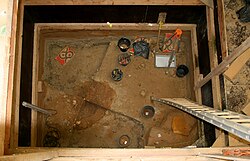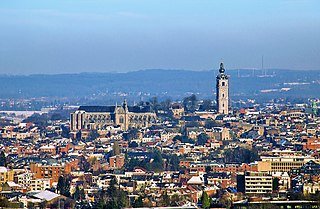
Mons is a city and municipality of Wallonia, and the capital of the province of Hainaut, Belgium.
Alphonse Briart (1825–1898) was supervisor of the coal mines at Bascoup and Mariemont near Morlanwelz in the Hainaut province of Belgium, and a geologist who studied that region. During the period 1863–1896 he and Francois Cornet published a number of books and papers describing fossils and geological structures found near Mons. They devised theories - now generally accepted - as to the geological history of the region. After Cornet's death in 1887, Briart continued to write alone.

The Langdale axe industry is the name given by archaeologists to a Neolithic centre of specialised stone tool production in the Great Langdale area of the English Lake District. The existence of the site, which dates from around 4,000–3,500 BC, was suggested by chance discoveries in the 1930s. More systematic investigations were undertaken by Clare Fell and others in the 1940s and 1950s, since when several field surveys of varying scope have been carried out.
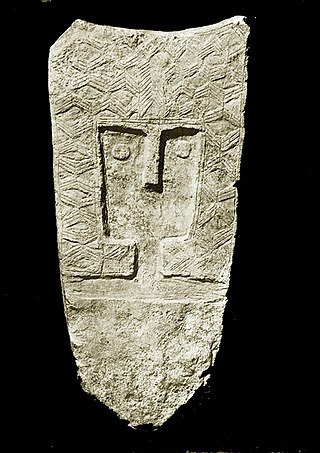
Chasséen culture is the name given to the archaeological culture of prehistoric France of the late Neolithic, which dates to roughly between 4500 BC and 3500 BC. The name "Chasséen" derives from the type site near Chassey-le-Camp (Saône-et-Loire).

Spiennes is a sub-municipality of the city of Mons located in the province of Hainaut, Wallonia, Belgium. It was a separate municipality until 1977. On 1 January 1977, it was merged into Mons.

Blandas is a commune in the Gard department in southern France. It is known for its proximity to the Cirque de Navacelles and the town encompasses one of the principal overlooks on the Cirque. It is also known for its exceptional megalithic sites. It is included in the UNESCO world heritage site "The Causses and the Cévennes, Mediterranean agro-pastoral Cultural Landscape"
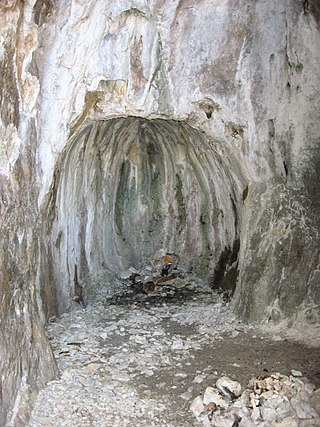
Fire-setting is a method of traditional mining used most commonly from prehistoric times up to the Middle Ages. Fires were set against a rock face to heat the stone, which was then doused with liquid, causing the stone to fracture by thermal shock. Some experiments have suggested that the water did not have a noticeable effect on the rock, but rather helped the miners' progress by quickly cooling down the area after the fire. This technique was best performed in opencast mines where the smoke and fumes could dissipate safely. The technique was very dangerous in underground workings without adequate ventilation. The method became largely redundant with the growth in use of explosives.
The history of Wallonia, from prehistoric times to the present day, is that of a territory which, since 1970, has approximately coincided with the territory of Wallonia, a federated component of Belgium, which also includes the smaller German-speaking Community of Belgium. Wallonia is the name colloquially given to the Walloon Region. The French word Wallonie comes from the term Wallon, itself coming from Walh. Walh is a very old Germanic word used to refer to a speaker of Celtic or Latin.
Peyre-Brune is a Neolithic dolmen situated near Saint-Aquilin in the department of the Dordogne, France.

Archaeology of Lebanon includes thousands of years of history ranging from Lower Palaeolithic, Phoenician, Roman, Arab, Ottoman, and Crusades periods.

Krzemionki, also Krzemionki Opatowskie, is a Neolithic and early Bronze Age complex of flint mines for the extraction of Upper Jurassic (Oxfordian) banded flints located about eight kilometers north-east of the Polish city of Ostrowiec Świętokrzyski. It is one of the largest known complexes of prehistoric flint mines in Europe together with Grime's Graves in England and Spiennes in Belgium.
Tell Aswad, Su-uk-su or Shuksa, is a large prehistoric, neolithic tell, about 5 hectares (540,000 sq ft) in size, located around 48 kilometres (30 mi) from Damascus in Syria, on a tributary of the Barada River at the eastern end of the village of Jdeidet el Khass.
Frédéric Abbès is a French archaeologist working on postdoctoral research, specialising in the stone or lithic industry of the Near East and Mediterranean. He has worked on important archaeological sites such as Tell Aswad and El Kowm.
The Sands of Beirut were a series of archaeological sites located on the coastline south of Beirut in Lebanon.
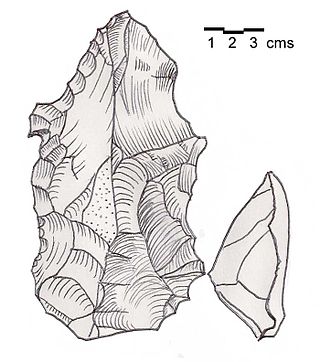
Heavy Neolithic is a style of large stone and flint tools associated primarily with the Qaraoun culture in the Beqaa Valley, Lebanon, dating to the Epipaleolithic or early Pre-Pottery Neolithic at the end of the Stone Age. The type site for the Qaraoun culture is Qaraoun II.

Pointe de la Torche is a promontory located at the southeastern end of the Baie d'Audierne in the commune of Plomeur in the Bigouden region of Finistère, France. It is an officially recognised natural site and at the top of the promontory is a prehistoric settlement and burial site that is registered as a historic monument.

Jean Auguste Hippolyte Houzeau de Lehaie was a Belgian biologist and horticulturist who devoted his career to the botany of bamboo species and the introduction of many into European gardening practice through his property, L'Hermitage, near Mons in the Belgian province of Hainaut. He was also a student of the temperate terrestrial orchids of Belgium and France.
Flint mining is the process of extracting flint from underground. Flint mines can be as simple as a pit on the surface or an area of quarrying, or it may refer to a series of shafts and tunnels used to extract flint.




